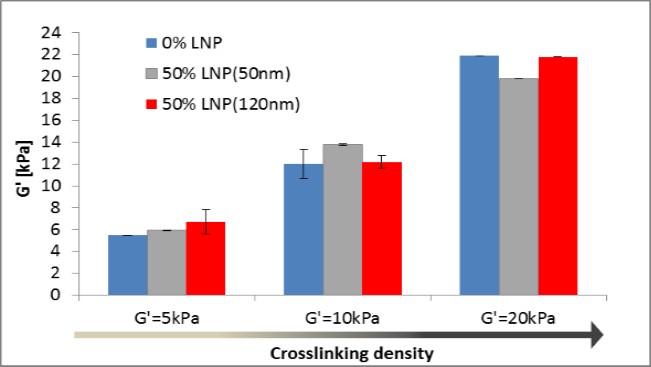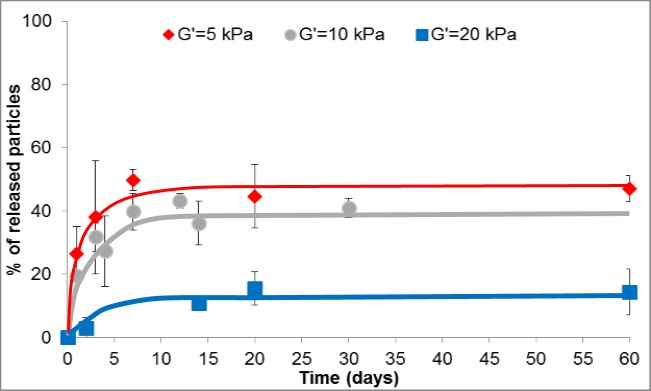Introduction: Biopolymer-based hydrogels find widespread applications in the field of regenerative medicine and drug delivery[1]. Hydrogels are able to provide local delivery of hydrophilic therapeutic agents, but the diffusion of agents from the hydrogels can be rapid and not easily time-controllable. On the other hand, nano-sized objects are being increasingly investigated for in vivo drug delivery[2]. In this regard, we have developed lipid nanoparticles (LNPs) as promising carriers for lipophilic drugs and therapeutic biomolecules[3].
The aim of the study presented herein is to develop original hybrid biomaterials composed of LNPs entrapped within hydrogels in view of their application for drug sustained release. In particular, we selected two biocompatible polysaccharides which are currently used in pharmaceutical and biomedical applications: carboxymethylcellulose (CMC) and chitosan, which are negatively and positively-charged respectively.
Experimental Method: CMC-PEG and chitosan-PEG hydrogels were chemically cross-linked using photo-induced thiol-ene chemistry[4]. Fluorescently labelled LNPs with different surface charge were prepared using a previously described sonication process[3], characterized by Dynamic Light Scattering (NanoSizer ZS, Malvern) and suspended into the polysaccharide solution before cross-linking to achieve the particle-loaded biomaterials. The physicochemical properties (swelling ratio, rheological properties (AR2000 rheometer, TA Instruments)) of the obtained hydrogels and the kinetics of release of the LNPs (fluorescence titration (LS50B fluorimeter, Perkin Elmer) were evaluated according to the surface charge and the concentration of particles entrapped into the hydrogels.
Results and Discussion: The loading of LNPs with two different diameter (50 nm and 120 nm), up to a concentration of 50% (wlipids/wpolymer), did not prevent the gel formation. The presence and the homogeneous distribution of the labelled LNPs within the hydrogels were confirmed by confocal laser scanning microscopy observations. No significant modifications of the rheological and swelling properties were observed for the obtained materials with different crosslinking density.

Similarly, particle hydrodynamic diameter and polydispersity index after their recovery from the digested material were not affected for a few weeks after material loading. LNPs were slowly released from the hydrogels. Interestingly, LNP released was sustained depending on the particle surface charge and the mechanical properties of the hydrogels.


Conclusion: LNPs were included in CMC-PEG and chitosan-PEG matrices with high payloads while not affecting material properties. Release of the particles was sustained in time and easily tunable with particle and material design.
Arcane Labex program
References:
[1] Van Vlierberghe S. et al., Biomacromol. 13:1818-1827, 2012.
[2] Natajaran J. V. et al., J. Control. Release 193:122-138, 2014.
[3] Delmas T. et al., J. Colloid Interf. Sci. 360:471-481, 2011.
[4] Hachet E. et al., Biomacromol. 13:1818-1827, 2012.